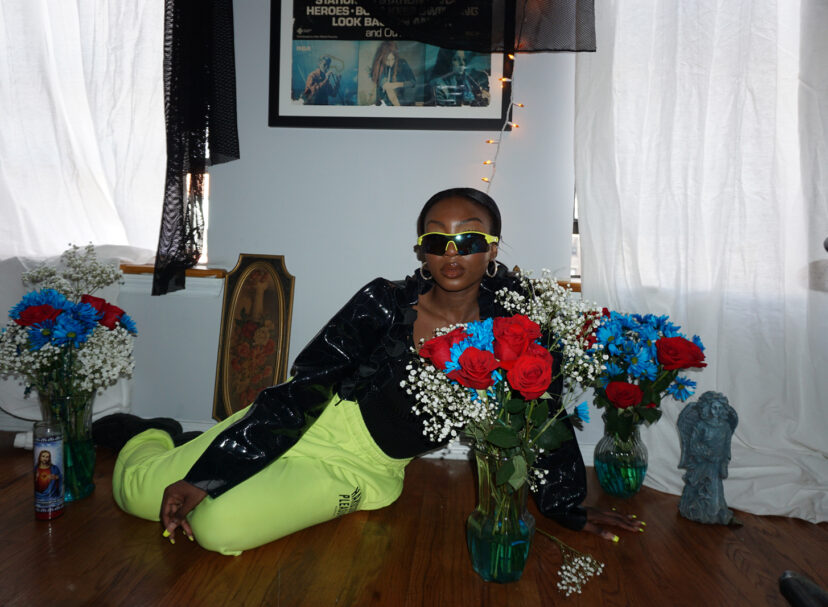Text: Alec Coiro
Photo: Kat Slootsky
In the grand globalization pageant, China seems to always be cast as the villain: the origin of the rusty containerships, the place where the factories spew the smoke, and where the materials are always irresponsible and carcinogenic.
The struggle against globalization is thus framed as a way of making things somewhere else, somewhere “local.” Producing locally will eschew global shipping and sweatshop labor. This sounds great and there’s a lot to like about this plan, but I’ve always found the position as a whole to be just a smidge unexamined. Global poverty rates have plummeted as globalization takes off, and the workers in China and Bangladesh and other global manufacturing hubs actively want the jobs that globalization is inflicting upon them.
So, it was refreshing to talk to Angel Chang whose work in fashion critiques globalization without making the Chinese worker either the culprit or the victim. Instead, she looks at China as the solution and finds a way forward hidden in the last place we’d think to look: the mountains of China among the Miao and the Dong people.

The Miao and the Dong — like the Tibetans, Koreans, and others — are two of the ethnic minorities that make up 10% of China’s population. These minority people that Chang came to know live in the mountains of southwest China, but in the story, she tells me, Chang’s first introduction to the Miao came in a far more cosmopolitan corner of China: a museum in Shanghai.
Chang had been aware of traditional Chinese costumes from her work as a womenswear designer at Donna Karan and going to museums for research. On one such museum visit, she was surprised to find that the costumes she was looking at were contemporary. She recalls,
“I went to the Shanghai Museum where they display ethnic minority costumes on the top floor with captions saying the year it was made and the village name. These all were made within the last 30 years, but they looked like they were from 100 years ago. I was really excited because this meant I could go directly to the people who made them and commission the same exact embroideries.”
Upon seeing these fabrics, Chang decamped the very same weekend to go find its source. When she got to the mountains, she recalls, “The translator and guide assigned to me by the travel agency just happened to have just escorted the collectors from the British Museum, who were buying up textiles in the region for the museum collections. He suggested I buy as much fabric as I could because the technique would die out in 5 to 10 years. As a designer, my first instinct was, ‘Where am I going to get my fabrics in 10 years then?” But I also felt like, “This is ridiculous to watch passively from the side. Why don’t you do something about it?’
But the twist in the narrative for me is that once Chang decided to do something about it, she still had to convince the people living there, who, it turns out, are happy living their life outside of capitalism. “I had to knock on everyone’s door and beg the grandmothers to show me their traditional fabrics, many of whom didn’t understand what interest a foreigner like me would have in their handwoven cloth. Even their children were not interested in learning about their fabrics. They had never sold their fabrics to anyone before, and it was always made for their own personal use and to make clothes for their family.”




Listening to Chang’s story, I quickly realized how conditioned I was to expect a “saved by Western capitalism” story emerges. But it turns out that the Miao and Dong are perfectly content as they are. “Before I thought my main mission would be to bring much-needed jobs to these villagers; after all, Guizhou province is the poorest province in China. But once I got there, I realized they are actually happier and more content with life than I expected. Sure, their life is hard and, until recent decades, some villagers could go a whole year without seeing cash. But this also had to do with them being self-sufficient farmers who could grow and make everything they needed to survive. They were not dependent on cash for survival, and so money doesn’t motivate them as much as you would think. It’s more about if they have time in their busy farming schedule and if they want to help you out.”
So Chang spent years fostering relationships with the local ethnic minority groups and developing an understanding of the differences between their villages. She’s currently arrived at the point where they look at her with what sounded to me like bemused affection. And so it turns out that this is not a story where western capitalism swoops in to save the villagers, but, perhaps, the beginning of a story where the west is saved from capitalism by the people in the village.
In a book that Chang is writing about her experiences creating her clothing collection with the Miao and the Dong, she writes about the way in which our understanding of craftsmanship under late capitalism is radically shallow. “The first third of the book,” Chang explains, “explains why craftsmanship is important and why Americans are so obsessed with artisanal production right now. Living abroad recently and returning to New York once or twice a year, I noticed poster ads all over the city selling all kinds of products — clothing, beer, coffee — as unique and “crafted.” Crafted is an over-used buzzword in marketing right now. All these marketers are using this word to justify selling products at a higher price.But there’s a study where 25% of Americans questioned, the largest group of responders, don’t even know what artisanal means. Europeans know what craftsmanship means because of their history of hundreds of years of family run business; and basically, all products before the industrial revolution were made by artisanal production. But in the U.S. we don’t have that history. So if I say something is artisanal, what does it actually mean? At McDonald’s, there’s an ‘artisanal’ grilled chicken sandwich now, apparently made by hand, and calling it ‘artisanal’ somehow justifies them to charge more for it.” I interject to ask if the McDonald’s hamburger is really made by hand. “All hamburgers are made by hand!” she exclaims. “How can you hand-craft a coffee; coffee’s always been made by hand. I just thought it was ridiculous. I saw an ad in Williamsburg that said, ‘Crafted floral-print georgette dress, go check it out at our store.’ I thought it was cool because it said it was hand- crafted, but I went to the store and it was just a normal dress machine-sewn in Portugal made from ordinary polyester fabric. It was such a disappointment. For me, craftsmanship is actually about the culture and the people, and the hand-crafted product is just the visual representation of the way these people view the world. I know what craftsmanship is now, but most people do not. And I wouldn’t have understood it if I hadn’t spent my time living with the artisans in the mountains.”

Before I thought my main mission would be to bring much-needed jobs to these villagers; after all, Guizhou province is the poorest province in China. But once I got there, I realized they are actually happier and more content with life than I expected. Sure, their life is hard and, until recent decades, some villagers could go a whole year without seeing cash. But this also had to do with them being self-sufficient farmers who could grow and make everything they needed to survive.

The artisanal craftsmanship that Chang describes the Miao practicing is much different and far more holistic than what is being sold to Americans. All the cotton they use, they’ve grown locally; if they want a certain color dye, they wait until the right flower is in bloom; they ferment vats of indigo in their homes throughout the year. “Natural fibers like hemp and linen have gone back 6000 years and natural dyes have gone back 5000 years in China. In fact, even longer because they existed before history was recorded. Chemical dyes have only been around since the 1850s and polyester only since around the 1950s, and there a lot of complications, like the dye wastewater is cancer-causing to humans and polluting the environment, synthetic fabric is not breathable and causes allergic reactions on the skin.”
In order to create a collection with the Miao and Dong, Chang has to completely upend the typical process she learned after years working in the fashion industry. “I have to do the opposite of what the industry normally does. I have to design based on the raw materials nature can provide throughout the year – according to the real seasons — and produce it all in the summer or the fall when the plants are fresh and flowers are in bloom. They don’t have indoor heat, so in the winter they don’t really go outside to dye fabrics; it’s just too cold. During the warmer months, everything is done outdoors. Because some villages didn’t start using electricity until the mid-1990’s, and even running water only a couple years ago, their daily lifestyle is based on working with sunrise, sunset, the seasons, and nature’s cycles. As a result, I have also learned to design based on nature’s calendar.” Her distinction between the fashion seasons and the actual seasons nicely sums up the way working with the ethnic minorities stips away artifice. It’s also important not to conflate the Miao and Dong she is working with into a homogenous group. Another large chunk of Chang’s production logistics involves coordinating which village has specialized in what she needs for each aspect of her collection. This is particularly true in the case of embroidery with each village having its own unique embroidery tradition. “I have to know all the stitches of the various villages and know which one to go to.” Embroidery, incidentally, is the aspect of the collection that will be created in the winter months because it’s done indoors.
Just as her production must follow a new logic, so too must her plans for distribution. “Normally, a designer would present a line of samples to stores, produce based on the order and deliver 3 months later; but in my case, that doesn’t work because there are a lot more variables involved when working with artisans and hand-made production. So I’ll spend as much time as the villagers need to perfect 100 pieces up front, then sell the products once they’re ready.”
We end the interview with Chang showing me a few pieces from the collection. They marvelous to look at as well as to touch. And it is no exaggeration to say that you can say that I can see the trace of the hand that made them. In fact “trace” may even be too subtle of a word.
For a more in-depth sense of what’s at stake, consider Chang’s recent TED-Ed video on the impact of the everyday t-shirt.


